EVERYTHING YOU NEED TO KNOW ABOUT TRANSFORMERS AND THEIR PRACTICAL USE
What is a transformer
The history of the transformer began to develop in the 19th century. The principle of the transformer is basically simple and is based on the laws of induction, which were stated already in 1833, according to which transformers are manufactured.
A transformer, colloquially also called a transformer, is a non-rotating electrical machine that works on the principle of electromagnetic induction (a phenomenon in which induced electromotive voltage and induced current occur in the conductor). It is used to convert electrical energy of a certain voltage into electrical energy of a different, possibly even of the same voltage, if the goal is to galvanically separate two electrical circuits.
The transformer changes the current voltage and voltage ratios in the circuit , while the frequency remains preserved. It only works with a voltage that changes over time, i.e. alternating or direct pulsating voltage. During the transformation, the power does not change , if we do not consider transformer losses, which consume a small part of the active power in the transformer itself.
In practice, single-phase and three-phase transformers are most often used and manufactured.
Production of custom-made transformers for the electrical industry
Different electronic devices have individual requirements for special equipment, so it is necessary and more advantageous to make a custom-made transformer for them. You can read more about the production of custom-made transformers here .
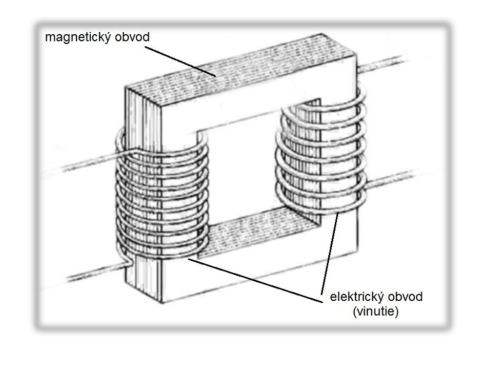
Fig. 1 Basic parts of the transformer - a design idea of the windings (a set of windings that forms an electric circuit and is connected to one of the voltages for the transformer or choke) of the transformer, the magnetic circuit and arrangement (1) (3).
Composition of the transformer
The transformer is composed of two or more circuits ( windings ) and one common magnetic circuit ( core - a ferromagnetic core is almost always used), which serves as a structural element .
Transformers connected to the electrical distribution network have their windings additionally covered with another insulating layer for safety reasons , or they are covered in a suitable potting compound .
The purpose of the transformer is to reduce, increase or make the voltage the same and its meaning is:
- in reducing investment costs,
- in long-distance transmission savings,
- in safety when consuming electricity.
The well-known discoverer Michael Faraday described the idea of a magnetic field in such a way that the magnetic flux creates a sum of induction lines passing through the investigated space, in our case the cross-section of a coil (a passive electrical element that is a real representation of inductance in an electrical circuit). The same flow also occurs around the coil, but in the opposite direction. Magnetic induction lines are closed lines and therefore the charge passing through the cross-section of the coil returns back through the space outside the coil. The magnitude of the magnetic flux can be determined by the number of induction lines in and outside the coil.
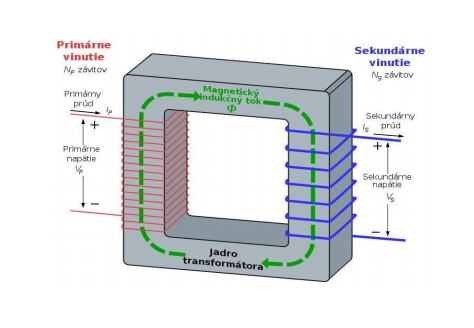
Fig.2 Principle of a single-phase core transformer
The unit of magnetic flux is the volt second .
Magnetic field
A magnetic field is a physical field in which the magnitudes of the field are the intensity of the magnetic field and the density of the magnetic flux . A magnetic field exists at a point if a force acts on moving electric charges or magnets at that point .
The magnetic field manifests itself as a hunting effect on iron objects or other magnets . It is located around a permanent magnet or around a conductor through which an electric current flows (and the field of a permanent magnet is actually caused by the movement of charges inside atoms) and is graphically represented by magnetic lines of force (induction lines).
The magnetic field is characterized by magnetic induction, which indicates the number of induction lines per unit area in relation. The main magnetic field in transformers is concentrated in the iron core , because it has a much better magnetic conductivity than air. The induced magnetic flux is proportional to the magnetic conductivity of the circuit and the force that induced it, which we call the magnetomotive force.
Magnetomotive force , also called flow or amperage (indicated in ammeters) is the sum of the currents passing through the excitation, the so-called window of the magnetic circuit. The magnetic conductivity of a circuit is the ratio of the magnetic flux and the magnetomotive force that induces it. It is numerically equal to the magnitude of the magnetic flux induced by a current of one ampere (7).
Division of transformers
According to the shape of the core, transformers are divided into:
- Nuclear transformers
- Shell transformers
- Toroidal transformers
1. Core transformers
For larger powers, core type transformers are used. The primary and secondary windings have cores on different poles.
2. Shell transformers
The winding is placed on the middle post, which has the largest cross-section. The magnetic flux is thus evenly distributed between the couplings and both side posts, which have a half cross-section.
The advantage of this arrangement is a good distribution of the magnetic flux and thus small dispersions, simple winding on one coil and relatively easy fixing of the core bundle. The disadvantage is worse cooling.
3. Toroidal transformers
The basis of the toroidal transformer is a circular core made of steel strip in different widths depending on the desired final dimensions and power of the transformer. The winding is placed around the entire circumference of the toroidal core.
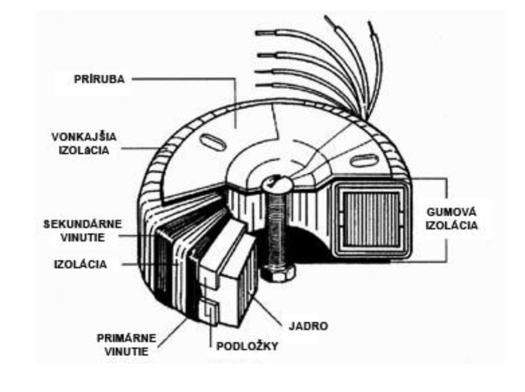
Fig. 3 Powerful toroidal transformer
Construction of small single-phase transformers

A transformer is a device that converts alternating currents and voltages with the same frequency, belongs to non-rotating electrical machines and works on the principle of electromagnetic induction.
According to the current assembly, transformers are divided into:
● Single-phase transformers
A single-phase transformer consists of two coils that share a mild steel core. The primary coil is connected to alternating current, which creates a variable magnetic field in the transformer core.
● Three-phase transformers
A three-phase transformer has a core with three poles, on one pole there can be two or three windings, which are connected to each other by two magnetic couplings. A three-phase transformer is used to transform three-phase current.
The principle of operation is exactly the same and the construction is very similar to that of a single-phase transformer. Each phase has its own primary and secondary coils, and they all share the same common core, just like a single-phase transformer. The primary and secondary coils are then connected to each other in a star or triangle.
● Multiphase transformers
A single-coil transformer is also called an autotransformer .
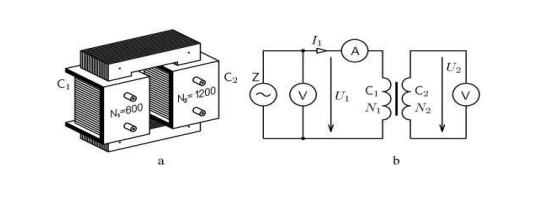
Fig. 4 Representation of a single-phase transformer and its connection diagram. It consists of two separate coils – primary and secondary, which are placed on a common mild steel core. An alternating current is supplied to the primary coil, which forms a periodic variable field in the core. As a result of the variable magnetic field, an electromotive voltage is induced in the windings of the coils.
A single-phase transformer is used, for example, in radios, televisions, and measuring instruments.
Three-phase transformers are used for the transformation of three-phase current in the energy industry , the construction of which is similar.
Transformer cooling
Powerful transformers must be cooled , as the winding is heated by the passage of electric current (passive resistance) and the core of the transformer is also heated by eddy magnetic currents .
Cooling is usually:
- Direct - the cooling medium circulates around the transformer coil.
- Indirect - the coil is separated from the medium.
Coolant circulation can be natural or forced. To cool the transformer in practice, we use: air (either passively or with a fan), oil , water , inert gas (a gas that does not undergo a chemical reaction under the given conditions), solid insulator (cooling by conduction) or other non-flammable liquids (3).
Voltage measurement by transformer
A measuring transformer is an electrical device that transforms primary current or voltage in a suitable range into secondary current or voltage, which are suitable for powering measuring or protection devices with the required accuracy.
Their use is in the energy industry, especially when measuring in circuits of high voltage and large currents , where they adjust the ranges of measuring or protective devices.
The purpose of measurements on the transformer is to determine the losses that arise in it during operation. From the losses, we calculate the efficiencies and the voltage drop from the load. Iron losses , Joule losses in the windings and additional losses occur in the transformer .
The use of a transformer is very advantageous because, in addition to the transformation defined by the number of turns, the measuring transformer also separates the measuring device (connected on the secondary side) from the primary circuit, which is connected to the measuring circuit.
Measuring current and voltage transformers thus transform large alternating voltages and currents into values suitable for direct measurement using measuring devices , so we use them to change the ranges of alternating voltmeters . These transformers also separate the measuring instruments from the circuits of the measured voltage. Measuring voltage transformers are used for both scaling up and scaling down . The primary winding is connected in parallel to the circuit whose voltage we want to measure. The rated secondary voltage of voltage measuring transformers is 100 V, exceptionally 110 V. We connect the measuring device to the secondary side. The primary voltage can reach up to 400 kV.
We divide according to the purpose of measurement into current and voltage , and their operation is based on the principle of operation of an ordinary transformer.
In a three-phase transformer we know:
- winding resistance measurement,
- voltage transfer measurement,
- empty measurement,
- short measurement (6).
Coil
A coil is a passive electrotechnical element that is a real representation of inductance in an electrical circuit . It consists of an insulated conductor wound (the winding can be single-layer or multi-layer ) on a non-conductive support frame .
We divide coils according to construction, shape, number of turns, but the most basic division is according to the core ( without a core - air and with a core - with a magnetic circuit).
Use of the coil
A coil that uses the force effects of the core's magnetic field is called an electromagnet .
The coil has three uses , namely:
- electromagnet – to create the magnetic field of an electric current, the generated magnetic force is used, pulling in the core (electric bell, electric motor, device control...),
- inductor (carrier of inductance) – serves to create an electric current induction by a magnetic field (LC circuits, radio technology...),
- for voltage transformation in transformers – induction creates an alternating magnetic field in the primary coil, which generates an electric voltage in the second coil of the transformer (secondary winding), while the voltage ratio is directly proportional to the ratio of the number of turns of the coils.
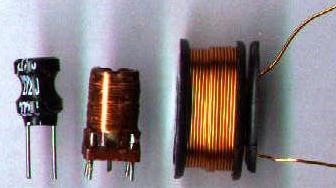
Fig. 5 Different types of coils.
Inductance
The basic physical quantity for a coil is inductance , which expresses the amount of magnetic flux induced by a given electric current and depends on the dimensions of the coil, the number of turns and the permeability of the core.
The unit of inductance is the henry .
Choke
Coil in the shape of a ring, or the cylinder is called a choke . A choke is a coil with a core (usually made of sheet metal or otroperm strips) and a large value of inductance, and its purpose is to filter out higher frequency signals in the electrical circuit, allowing lower frequency signals and direct current with a small resistance (4) (5).
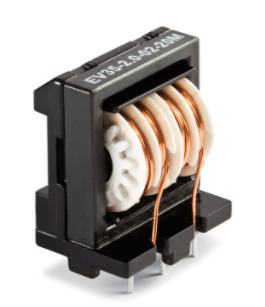
Fig. 6 Throttle .
Use of coils
The coils are always intended for some specific targeted product (e.g. radio receiver, oscillator...) and are not produced in large numbers for different uses.
Used literature:
- KAŠPAR Jakub, TRANSFORMÁTORY, Technická univerzita v Košiciach, Fakulta elektrotechniky a informatiky
- MIKOLÁŠ Ján, TRANSFORMÁTORY, ICH VLASTNOSTI A METÓDY MERANIA, Dubnický technologický inštitút v Dubnici nad Váhom DTI DTI
- https://sk.wikipedia.org/wiki/Transform%C3%A1tor
- https://sk.wikipedia.org/wiki/Cievka_(elektrotechnika)
- https://sk.wikipedia.org/wiki/Tlmivka
- Meranie na transformátore, Elektrické stroje, Technická univerzita v Košiciach, Fakulta elektrotechniky a informatiky, Katedra elektrotechniky a mechatroniky
- https://sk.wikipedia.org/wiki/Magnetick%C3%A9_pole

